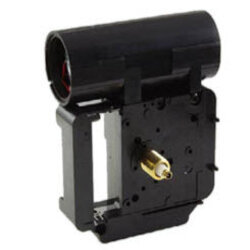Don't wanna be here? Send us removal request.
Text
Trending Electronic Clock Movements

Clock movements are the engines, or motors, that control the turning and also positioning of the hands for correct time telling. Clock movements were generally mechanical and also analog, yet in modern times they are nearly specifically electronic, as well as either analog or digital. In any case, the feature needed boils down to the dimension of the angle subtended by each hand at every minute.
Clock movements are frequently referred to as electric motors, and also the terms are basically interchangeable. The force behind a mechanical one was either a coiled spring or a hanging weight triggering a flywheel to transform. To prevent "freewheeling," or runaway rotation, pendulums as well as escapement devices were used, developing an oscillation that had actually a particularly derived regularity.
The modern-day digital motion derives its power from a quartz crystal shaking at a certain frequency that corresponds to the geometry of the crystal. With a voltage decline related to the crystal, it discharges a series of pulses at the powerful frequency. Building up the variety of pulses right into a digital register monitors the amount of expired time.
This running total amount of pulses is a high multiple of the secs and also mins required for informing time, so software application partitions the number to something useful. The mechanical analog of this procedure is achieved utilizing a network of equipments in certain ratios. In both the digital and mechanical technique, the breakthrough of every second causes the pre-owned to subtend another 6 degrees of arc.
An additional register accumulates secs right into mins, and also a third matters minutes right into hrs. When the matching limit is crossed, the family member hand is advanced another tick. Ultimately, each register gets reset back to absolutely no, developing a total cycle when everything begins again once more.
This "ultimately" generally suggests 12 hours, yet there's no reason it can't be extended well past that. It's basically no more challenging than setting a specification in the motion software. So, it's very easy to double the cycle to 24 hours (which would certainly call for a various dial), yet easily offered are motors that head out a week or even a month.
These last 2 extensions ask for an extra hand to indicate the day of the week or the date in the month, respectively. Yet a various type of expansion uses a cycle of 24 hr and also 50 mins, which corresponds to the duration of the lunar transformation around the planet. Thus, it can be utilized to present the existing degree of the trend (if adjusted to your area of the sea).
There are also movements for showing weather condition sensations, such as temperature or moisture. Unlike the trend degree, which is a periodic reappearance like time, such phenomena differ within a certain variety, as well as the values need to be digitized from sensing unit input. The corresponding dial is calibrated to make sure that the hand revolves via less than one full circle.
Note that electronic clock movements can so much greater than their mechanical equivalents due to the software program facet. The physical positioning of the hand or hands is the same for both, however the derivation of placement is an order of magnitude much more complicated for the mechanical variation.
Movements show function collections, as well as some features we haven't also defined. Bear in mind that conventional electric motors are developed for clocks less than 12-14 inches in size, as their torque limitation can not turn longer minute hands. It is possible to build larger clocks (align to 6 feet across!), yet you have to get the high-torque version of the activity the feature set of which you wish to implement.
Many motors run on batteries (usually AA or C), though other power alternatives are in some cases offered. You can additionally discover uniqueness such as pendulums or chimes. There is no end to the pleasure one can originate from contemporary electronic clock movements.
clock parts
youtube
1 note
·
View note